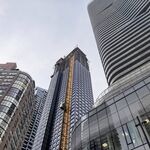Nope. Roads will continue to be necessary, but to a lesser degree. I suspect a fairly advanced PRT system would see more, smaller freight vehicles.
That's the point. PRT working as a full on replacement to roads would be a huge, huge, huge capital investment for some trivial gains (since we're assuming that you're not building PRT infrastructure all through every little subdivision cul de sac and so people will have to walk or carry their goods to their house.) Using PRT as a type of transit really doesn't work either, because you've got much more economical ways of providing transit to lots of people (I'll bet that in real world costs, PRT would be on the same capital investment level as an elevated subway.)
Of course PRT isn't door to door, but it's certainly feasible to get people within a couple hundred meters of their destination for many of the trips they would make. Of course you're not going to carry a sofa or a refrigerator on a PRT vehicle, but you're not going to put it in your car, robo or otherwise, either.
You're making unsubstantiated claims about how much a PRT system would cost. Claiming it must cost as much elevated subway is patently absurd, from an engineering perspective. How could there be no incremental cost over building infrastructure to carry ~1 tonne vehicles to carry a 40 tonne subway train*. Do you really believe that?
Edit: I made a mistake: apparently each car is about 40 tonnes. So for a 6 car train, that works out to closer to 240 tonnes.
PRT isn't about ripping out our existing road infrastructure, but diminishing the need for new road infrastructure. Nor would PRT replace all transit, but rather it would complement it. The level of road infrastructure investment to provide a similar service level to PRT in a region like the GTA would be astronomical. We simply don't have the land. If we don't invest huge amounts of money in new roads, we will experience crippling congestion over the coming decades.
In terms of real world costs, Heathrow has built a pilot PRT system. The cost has not been unacceptable for BAA to propose significantly expanding the system provided it operates as planned. The system when built out
should cost 3 million pounds per km including vehicles. You're suggesting that this estimate is off by a factor of roughly 30 (to be fair, some of the track is at ground level, but a significant amount is elevated). The system is also expected to cover both operating and capital costs, with positive NPV at 6% discounting. Maybe they are optimistic, but I doubt they're off by a factor of 30. This is only baby steps, and far from a PRT system I would like to see rolled out in urban areas--it certainly has plenty of flaws. But as a proof of the technology, and it's ability to provide a high level of service at low total system cost, I think it's pretty valuable.




